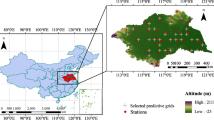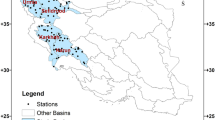Abstract
In order to issue an accurate warning for flood, a better or appropriate quantitative forecasting of precipitation is required. In view of this, the present study intends to validate the quantitative precipitation forecast (QPF) issued during southwest monsoon season for six river catchments (basin) under the flood meteorological office, Patna region. The forecast is analysed statistically by computing various skill scores of six different precipitation ranges during the years 2011–2014. The analysis of QPF validation indicates that the multi-model ensemble (MME) based forecasting is more reliable in the precipitation ranges of 1–10 and 11–25 mm. However, the reliability decreases for higher ranges of rainfall and also for the lowest range, i.e., below 1 mm. In order to testify synoptic analogue method based MME forecasting for QPF during an extreme weather event, a case study of tropical cyclone Phailin is performed. It is realized that in case of extreme events like cyclonic storms, the MME forecasting is qualitatively useful for issue of warning for the occurrence of floods, though it may not be reliable for the QPF. However, QPF may be improved using satellite and radar products.














Similar content being viewed by others
References
Agnihotri G and Panda J 2014 Comparison of rainfall from ordinary and automatic rain gauges in Karnataka; Mausam 65(4) 575–584.
Apte N Y, Kaur S and Das A K 2011 Performance of IMD multi-model ensemble and WRF based sub-basin wise rainfall forecast for Mahanadi basin during Flood Season (Monsoon) 2009 and 2010, Met Monograph: Synoptic Meteorology No. 11/2011, IMD.
Das A K, Gupta A K, Halder R N, Laxmi V and Awasthi J 2011 Performance of IMD multi-model ensemble (MME) and WRF (ARW) based sub-basin wise rainfall forecast for Mahanadi basin during flood season 2011; Vayu Mandal 37 110–122.
Das S, Kar N S and Bandyopadhyay S 2015 Glacial lake outburst flood at Kedarnath, Indian Himalaya: A study using digital elevation models and satellite images; Natural Hazards 77 769–786.
Dhar O N and Nandergi S 1993 Spatial distribution of severe rainstorms over India and their associated rainfall depths; Mausam 44 373–380.
Gerapetritis H and Pelissier J M 2004 On the behavior of the critical success index; Eastern region technical attachment, No. 2004-03.
Gibergans-Báguena J and Llasat M C 2007 Improvement of the analog forecasting method by using local thermodynamic data. Application to autumn precipitation in Catalonia; Atmos. Res. 86 173–193.
Giri R K, Prakash S, Kumar R and Panda J 2012 Significance of scatterometer winds data in weak vortices diagnosis in Indian seas; Int. J. Phys. Math. Sci. 2 19–26.
Goswami B N, Venugopal V, Sengupta D, Madhusoodanan M S and Xavier P K 2006 Increasing trend of extreme rain events over India in a warming environment; Science 134 1442–1445.
Guhathakurta P, Sreejith O P and Menon P A 2011 Impact of climate change on extreme rainfall events and flood risk in India; J. Earth Syst. Sci. 120 359–373.
IMD 2013 Very severe cyclonic storm Phailin over the Bay of Bengal (08–14 October 2013): A report. Cyclone Warning Division, India Meteorological Department New Delhi, 43p, http://www.imd.gov.in/section/nhac/dynamic/phailin.pdf.
IPCC 2007 Climate change 2007: Synthesis report; 52p, https://www.ipcc.ch/pdf/assessment-report/ar4/syr/ar4_syr.pdf.
Krishnamurti T N, Kishtawal C M, LaRow T E, Bachiochi D R, Zhang Z, Williford C E, Gadgil S and Surendran S 1999 Improved weather and seasonal climate forecasts from multi-model superensemble; Science 285 1548–1550.
Lal J, Day J S and Kapoor K K 1989 Synoptic analogue method for issue of semi QPF for Gomati catchment; Mausam 34 309–312.
Mandal V, De U K and Basu B K 2007 Precipitation forecast verification of the Indian summer monsoon with intercomparison of three diverse regions; Wea. Forecasting 22 428–443.
Mirza M M Q 2003 Three recent extreme floods in Bangladesh: A hydro-meteorological analysis; Natural Hazards 28 35–64.
Mitra A K, Iyengar G R. D. V R, Sanjay J, Krishnamurti T N, Mishra A and Sikka D R 2011 Experimental real-time multi-model ensemble (MME) prediction of rainfall during monsoon 2008: Large-scale medium-range aspects; J. Earth Syst. Sci. 120 27–52.
Mohanty U C and Dimri A P 2004 Location-specific prediction of the probability of occurrence and quantity of precipitation over western Himalayas; Wea. Forecasting 19 520–533.
Mohanty U C, Ravi N and Madan O P 2001 Forecasting precipitation over Delhi during the southwest monsoon season; Meteorol. Appl. 8 11–21.
Panda J and Giri R K 2012 A comprehensive study of surface and upper air characteristics over two stations on the west coast of India during the occurrence of a cyclonic storm; Natural Hazards 64 1055–1078.
Panda J, Giri R K, Patel K H, Sharma A K and Sharma R K 2011 Impact of satellite derived winds and cumulus physics during the occurrence of the tropical cyclone Phyan; Indian J. Sci. Technol. 4 859–875.
Panda J, Singh H, Giri R K and Routray A 2015 A qualitative study of some of the meteorological features during tropical cyclone PHET using satellite observations and WRF modeling system; J. Indian Soc. Remote Sens. 43 45–56.
Ram L C and Kaur S 2004 Quantitative precipitation forecast for Upper Yammuna Catchment by synoptic analogue method; Mausam 55 508–511.
Ram L C and Pangasa N K 2000 Semi-quantitative precipitation forecast for Ghagra catchments by synoptic analogue method; Mausam 51 85–87.
Ray K and Patel D M 2000 Semi-QPF model for River Narmada by Synoptic Analogue method; Mausam 51 88–90.
Ray K and Sahu M L 1998 A synoptic analogue model for QPF of river Sabarmati basin; Mausam 49 499–502.
Roy Bhowmik S K and Durai V R 2012 Development of multi-model ensemble based district level medium range rainfall forecast system for Indian region; J. Earth Syst. Sci. 121 273–285.
Schaefer J T 1990 The critical success index as an indicator of warning skill; Wea. Forecasting 5 570–575.
Singh K M, Prasad M C and Prasad G 2010a Semi quantitative forecasts for Baghmati/Adhwara Group of rivers/Kamala Balan catchments by synoptic analogue technique; Mausam 61 337–348.
Singh K M, Prasad M C, Prasad G, Prasad R and Jha M K 2010b Semi-quantitative precipitation forecasts for Kosi/Mahananda catchment by synoptic analogue method; Mausam 61 175–186.
Acknowledgements
Authors are grateful to the Director General of Meteorology for the accomplishment of this work. The suggestions and help of Regional Meteorological Centre Patna staffs are also duly acknowledged. The authors would also like to appreciate and express their thanks for the valuable comments and suggestions from the anonymous reviewers, which helped in overall improvement of the manuscript.
Author information
Authors and Affiliations
Corresponding author
Additional information
Corresponding editor: Pradeep Kumar Thapliyal
Appendix
Appendix
The simplest forecast can be categorically either ‘yes’ or ‘no’ forecast of occurrence of a phenomenon like a rain event. In order to understand the verification measures used for forecast evaluation let us consider a contingency table as follows:
In this table, X1 indicates the case when the event (the flood in this case) is actually observed (observed occurrence) and also predicted to occur (forecast occurrence). Y1 indicates an event which is not observed in reality (observed non-occurrence) whereas it is predicted to occur. When an event is predicted not to occur (forecast non-occurrence) whereas it occurs in reality then it is classified as X2 otherwise (observed non-occurrence) it is denoted by Y2. In view of this, the total number of forecasts generated is given by
Now, the probability of detection (POD) can be written as:
False alarm rate (FAR) is given by the following equation:
Missing rate (MR) is calculated as:
Similarly, the values of correct non-occurrence of C-NON can be computed as:
The critical success index (CSI) is given by:
Bias for occurrence (abbreviated as BIAS) of the event can be computed as:
Percentage correct (PC) values can be computed as:
True skill score (TSS) can be determined by the following formulation:
Similarly, another skill score known as Heidke skill score (HSS) can be computed in a relatively complex manner as follows:
Rights and permissions
About this article
Cite this article
Giri, R.K., Panda, J., Rath, S.S. et al. Validating quantitative precipitation forecast for the Flood Meteorological Office, Patna region during 2011–2014. J Earth Syst Sci 125, 709–723 (2016). https://doi.org/10.1007/s12040-016-0690-1
Received:
Revised:
Accepted:
Published:
Issue Date:
DOI: https://doi.org/10.1007/s12040-016-0690-1




